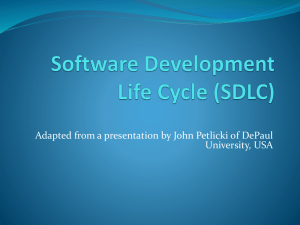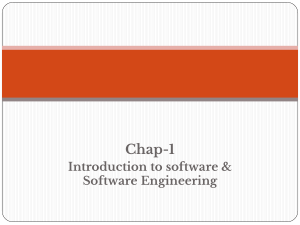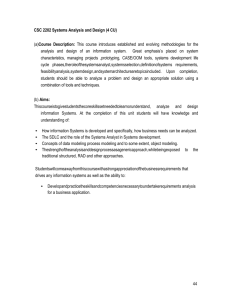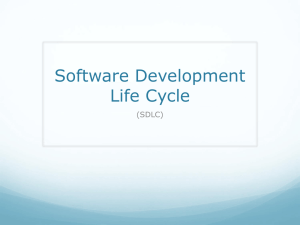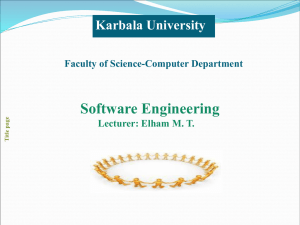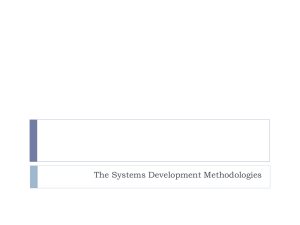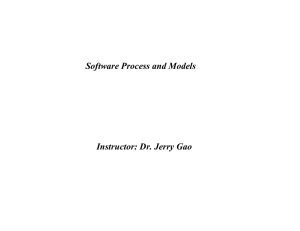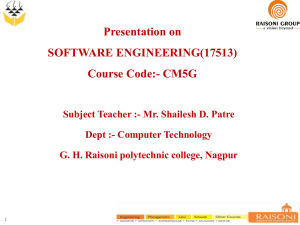Software Development Life Cycle (SDLC)
advertisement
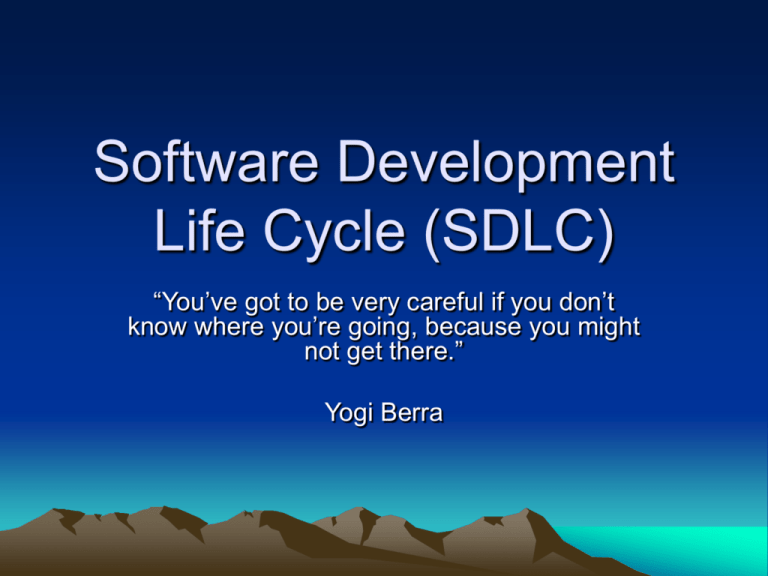
Software Development Life Cycle (SDLC) “You’ve got to be very careful if you don’t know where you’re going, because you might not get there.” Yogi Berra Capability Maturity Model (CMM) • A bench-mark for measuring the maturity of an organization’s software process • CMM defines 5 levels of process maturity based on certain Key Process Areas (KPA) CMM Levels Level 5 – Optimizing (< 1%) -- process change management -- technology change management -- defect prevention Level 4 – Managed (< 5%) -- software quality management -- quantitative process management Level 3 – Defined (< 10%) -- peer reviews -- intergroup coordination -- software product engineering -- integrated software management -- training program -- organization process definition -- organization process focus Level 2 – Repeatable (~ 15%) -- software configuration management -- software quality assurance -- software project tracking and oversight -- software project planning -- requirements management Level 1 – Initial (~ 70%) SDLC Model A framework that describes the activities performed at each stage of a software development project. Waterfall Model • Requirements – defines needed information, function, behavior, performance and interfaces. • Design – data structures, software architecture, interface representations, algorithmic details. • Implementation – source code, database, user documentation, testing. Waterfall Strengths • • • • • • Easy to understand, easy to use Provides structure to inexperienced staff Milestones are well understood Sets requirements stability Good for management control (plan, staff, track) Works well when quality is more important than cost or schedule Waterfall Deficiencies • All requirements must be known upfront • Deliverables created for each phase are considered frozen – inhibits flexibility • Can give a false impression of progress • Does not reflect problem-solving nature of software development – iterations of phases • Integration is one big bang at the end • Little opportunity for customer to preview the system (until it may be too late) When to use the Waterfall Model • • • • • Requirements are very well known Product definition is stable Technology is understood New version of an existing product Porting an existing product to a new platform. V-Shaped SDLC Model • A variant of the Waterfall that emphasizes the verification and validation of the product. • Testing of the product is planned in parallel with a corresponding phase of development V-Shaped Steps • Project and Requirements Planning – allocate resources • • Product Requirements and Specification Analysis – complete specification of the software system • • Architecture or High-Level Design – defines how software functions fulfill the design • Integration and Testing – check that modules interconnect correctly • Detailed Design – develop algorithms for each architectural component • Unit testing – check that each module acts as expected • Coding – transform algorithms into software Production, operation and maintenance – provide for enhancement and corrections System and acceptance testing – check the entire software system in its environment V-Shaped Strengths • Emphasize planning for verification and validation of the product in early stages of product development • Each deliverable must be testable • Project management can track progress by milestones • Easy to use V-Shaped Weaknesses • Does not easily handle concurrent events • Does not handle iterations or phases • Does not easily handle dynamic changes in requirements • Does not contain risk analysis activities When to use the V-Shaped Model • Excellent choice for systems requiring high reliability – hospital patient control applications • All requirements are known up-front • When it can be modified to handle changing requirements beyond analysis phase • Solution and technology are known Structured Evolutionary Prototyping Model • Developers build a prototype during the requirements phase • Prototype is evaluated by end users • Users give corrective feedback • Developers further refine the prototype • When the user is satisfied, the prototype code is brought up to the standards needed for a final product. Structured Evolutionary Prototyping Steps • A preliminary project plan is developed • An partial high-level paper model is created • The model is source for a partial requirements specification • A prototype is built with basic and critical attributes • The designer builds – the database – user interface – algorithmic functions • The designer demonstrates the prototype, the user evaluates for problems and suggests improvements. • This loop continues until the user is satisfied Structured Evolutionary Prototyping Strengths • Customers can “see” the system requirements as they are being gathered • Developers learn from customers • A more accurate end product • Unexpected requirements accommodated • Allows for flexible design and development • Steady, visible signs of progress produced • Interaction with the prototype stimulates awareness of additional needed functionality Structured Evolutionary Prototyping Weaknesses • Tendency to abandon structured program development for “code-and-fix” development • Bad reputation for “quick-and-dirty” methods • Overall maintainability may be overlooked • The customer may want the prototype delivered. • Process may continue forever (scope creep) When to use Structured Evolutionary Prototyping • Requirements are unstable or have to be clarified • As the requirements clarification stage of a waterfall model • Develop user interfaces • Short-lived demonstrations • New, original development • With the analysis and design portions of objectoriented development. Rapid Application Model (RAD) • Requirements planning phase (a workshop utilizing structured discussion of business problems) • User description phase – automated tools capture information from users • Construction phase – productivity tools, such as code generators, screen generators, etc. inside a time-box. (“Do until done”) • Cutover phase -- installation of the system, user acceptance testing and user training RAD Strengths • Reduced cycle time and improved productivity with fewer people means lower costs • Time-box approach mitigates cost and schedule risk • Customer involved throughout the complete cycle minimizes risk of not achieving customer satisfaction and business needs • Focus moves from documentation to code (WYSIWYG). • Uses modeling concepts to capture information about business, data, and processes. RAD Weaknesses • Accelerated development process must give quick responses to the user • Risk of never achieving closure • Hard to use with legacy systems • Requires a system that can be modularized • Developers and customers must be committed to rapid-fire activities in an abbreviated time frame. When to use RAD • • • • • • • Reasonably well-known requirements User involved throughout the life cycle Project can be time-boxed Functionality delivered in increments High performance not required Low technical risks System can be modularized Incremental SDLC Model • Construct a partial implementation of a total system • Then slowly add increased functionality • The incremental model prioritizes requirements of the system and then implements them in groups. • Each subsequent release of the system adds function to the previous release, until all designed functionality has been implemented. Incremental Model Strengths • • • • • • • • Develop high-risk or major functions first Each release delivers an operational product Customer can respond to each build Uses “divide and conquer” breakdown of tasks Lowers initial delivery cost Initial product delivery is faster Customers get important functionality early Risk of changing requirements is reduced Incremental Model Weaknesses • Requires good planning and design • Requires early definition of a complete and fully functional system to allow for the definition of increments • Well-defined module interfaces are required (some will be developed long before others) • Total cost of the complete system is not lower When to use the Incremental Model • Risk, funding, schedule, program complexity, or need for early realization of benefits. • Most of the requirements are known up-front but are expected to evolve over time • A need to get basic functionality to the market early • On projects which have lengthy development schedules • On a project with new technology Spiral SDLC Model • Adds risk analysis, and 4gl RAD prototyping to the waterfall model • Each cycle involves the same sequence of steps as the waterfall process model Spiral Quadrant Determine objectives, alternatives and constraints • Objectives: functionality, performance, hardware/software interface, critical success factors, etc. • Alternatives: build, reuse, buy, sub-contract, etc. • Constraints: cost, schedule, interface, etc. Spiral Quadrant Evaluate alternatives, identify and resolve risks • Study alternatives relative to objectives and constraints • Identify risks (lack of experience, new technology, tight schedules, poor process, etc. • Resolve risks (evaluate if money could be lost by continuing system development Spiral Quadrant Develop next-level product • Typical activites: – Create a design – Review design – Develop code – Inspect code – Test product Spiral Quadrant Plan next phase • Typical activities – Develop project plan – Develop configuration management plan – Develop a test plan – Develop an installation plan Spiral Model Strengths • Provides early indication of insurmountable risks, without much cost • Users see the system early because of rapid prototyping tools • Critical high-risk functions are developed first • The design does not have to be perfect • Users can be closely tied to all lifecycle steps • Early and frequent feedback from users • Cumulative costs assessed frequently Spiral Model Weaknesses • Time spent for evaluating risks too large for small or lowrisk projects • Time spent planning, resetting objectives, doing risk analysis and prototyping may be excessive • The model is complex • Risk assessment expertise is required • Spiral may continue indefinitely • Developers must be reassigned during non-development phase activities • May be hard to define objective, verifiable milestones that indicate readiness to proceed through the next iteration When to use Spiral Model • • • • • • • • When creation of a prototype is appropriate When costs and risk evaluation is important For medium to high-risk projects Long-term project commitment unwise because of potential changes to economic priorities Users are unsure of their needs Requirements are complex New product line Significant changes are expected (research and exploration) Agile SDLC’s • Speed up or bypass one or more life cycle phases • Usually less formal and reduced scope • Used for time-critical applications • Used in organizations that employ disciplined methods Some Agile Methods • • • • • • • • Adaptive Software Development (ASD) Feature Driven Development (FDD) Crystal Clear Dynamic Software Development Method (DSDM) Rapid Application Development (RAD) Scrum Extreme Programming (XP) Rational Unify Process (RUP) Extreme Programming - XP For small-to-medium-sized teams developing software with vague or rapidly changing requirements Coding is the key activity throughout a software project • Communication among teammates is done with code • Life cycle and behavior of complex objects defined in test cases – again in code XP Practices (1-6) 1. Planning game – determine scope of the next release by combining business priorities and technical estimates 2. Small releases – put a simple system into production, then release new versions in very short cycle 3. Metaphor – all development is guided by a simple shared story of how the whole system works 4. Simple design – system is designed as simply as possible (extra complexity removed as soon as found) 5. Testing – programmers continuously write unit tests; customers write tests for features 6. Refactoring – programmers continuously restructure the system without changing its behavior to remove duplication and simplify XP Practices (7 – 12) 7. Pair-programming -- all production code is written with two programmers at one machine 8. Collective ownership – anyone can change any code anywhere in the system at any time. 9. Continuous integration – integrate and build the system many times a day – every time a task is completed. 10. 40-hour week – work no more than 40 hours a week as a rule 11. On-site customer – a user is on the team and available full-time to answer questions 12. Coding standards – programmers write all code in accordance with rules emphasizing communication through the code XP is “extreme” because Commonsense practices taken to extreme levels • If code reviews are good, review code all the time (pair programming) • If testing is good, everybody will test all the time • If simplicity is good, keep the system in the simplest design that supports its current functionality. (simplest thing that works) • If design is good, everybody will design daily (refactoring) • If architecture is important, everybody will work at defining and refining the architecture (metaphor) • If integration testing is important, build and integrate test several times a day (continuous integration) • If short iterations are good, make iterations really, really short (hours rather than weeks) XP References Online references to XP at • http://www.extremeprogramming.org/ • http://c2.com/cgi/wiki?ExtremeProgrammingRoadmap • http://www.xprogramming.com/ Feature Driven Design (FDD) Five FDD process activities 1. Develop an overall model – Produce class and sequence diagrams from chief architect meeting with domain experts and developers. 2. Build a features list – Identify all the features that support requirements. The features are functionally decomposed into Business Activities steps within Subject Areas. Features are functions that can be developed in two weeks and expressed in client terms with the template: <action> <result> <object> i.e. Calculate the total of a sale 3. 4. 5. Plan by feature -- the development staff plans the development sequence of features Design by feature -- the team produces sequence diagrams for the selected features Build by feature – the team writes and tests the code http://www.nebulon.com/articles/index.html Dynamic Systems Development Method (DSDM) Applies a framework for RAD and short time frames Paradigm is the 80/20 rule – majority of the requirements can be delivered in a relatively short amount of time. DSDM Principles 1. 2. 3. 4. 5. 6. 7. 8. 9. Active user involvement imperative (Ambassador users) DSDM teams empowered to make decisions Focus on frequent product delivery Product acceptance is fitness for business purpose Iterative and incremental development - to converge on a solution Requirements initially agreed at a high level All changes made during development are reversible Testing is integrated throughout the life cycle Collaborative and co-operative approach among all stakeholders essential DSDM Lifecycle • Feasibility study • Business study – prioritized requirements • Functional model iteration – risk analysis – Time-box plan • Design and build iteration • Implementation Adaptive SDLC Combines RAD with software engineering best practices • Project initiation • Adaptive cycle planning • Concurrent component engineering • Quality review • Final QA and release Adaptive Steps 1. Project initialization – determine intent of project 2. Determine the project time-box (estimation duration of the project) 3. Determine the optimal number of cycles and the time-box for each 4. Write an objective statement for each cycle 5. Assign primary components to each cycle 6. Develop a project task list 7. Review the success of a cycle 8. Plan the next cycle Tailored SDLC Models • Any one model does not fit all projects • If there is nothing that fits a particular project, pick a model that comes close and modify it for your needs. • Project should consider risk but complete spiral too much – start with spiral & pare it done • Project delivered in increments but there are serious reliability issues – combine incremental model with the V-shaped model • Each team must pick or customize a SDLC model to fit its project Agile Web references DePaul web site has links to many Agile references http://se.cs.depaul.edu/ise/agile.htm Quality – the degree to which the software satisfies stated and implied requirements • Absence of system crashes • Correspondence between the software and the users’ expectations • Performance to specified requirements Quality must be controlled because it lowers production speed, increases maintenance costs and can adversely affect business Quality Assurance Plan • The plan for quality assurance activities should be in writing • Decide if a separate group should perform the quality assurance activities • Some elements that should be considered by the plan are: defect tracking, unit testing, source-code tracking, technical reviews, integration testing and system testing. Quality Assurance Plan • Defect tracing – keeps track of each defect found, its source, when it was detected, when it was resolved, how it was resolved, etc • Unit testing – each individual module is tested • Source code tracing – step through source code line by line • Technical reviews – completed work is reviewed by peers • Integration testing -- exercise new code in combination with code that already has been integrated • System testing – execution of the software for the purpose of finding defects.
